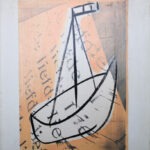COLLECTION ZOOM
Elma van Haren
BIOGRAPHY
Born
1954 Roosendaal
Residence
Amsterdam
Education
1972-1977 ArtAcademy Den Bosch, The Netherlands
Elma van Haren is a writer of prose, stories and poetry as well as a visual artist.
Since the poetry collection De wiedeweerga (1998), she has also written for children.
Elma van Haren was a member of the jury for:
C. Buddingh’ Prize 1990, 2006.
Gelderse Debuten 1991.
Herman Gorter Prize 1993.
P.C. Hooft-prijs 2003.
Gedichtendagprijs 2009.
Since 2003, she has been a jury member of the P.C. Hooft Prize.
Elma van Haren was born in Roosendaal. The family moved to Boxmeer in 1966. At the age of seventeen, Van Haren obtained her gymnasium diploma, after which she studied for five years (from 1972) at the art academy in ‘s-Hertogenbosch.
In 1979, she moved to Amsterdam. Later she lived in Heks (Belgium). In the 1980s, she travelled to South America and Africa.
In 1988, she made her debut with the poetry collection De reis naar het welkom geheten [The journey to the welcome], which was highly praised and won her the C. Buddingh’-prijs. In 1989, the collection De wankel (The wobbly) appeared, which was considered a confirmation of her talent. This was followed in 1991 by a third collection of poetry, Het schuinvallend oog (The Slanting Eye), marked on the title page as ‘diary poems’. This last collection is about turning events of a certain day into poems, but in fact this was often the case in her previous collections as well.
Van Haren’s poetry is characterised by loose rhyme and an idiosyncratic typography, as if impressions and fragments were randomly linked. It is based on a certain way of looking at the things she sees, which she herself refers to as ‘cross-thinking’, a way of seeing in which both analytical and synthesising thinking are brought into play. In her poetry, the controversy between distance and involvement, between which a bridge must be built, keeps recurring. Van Haren’s poetry arises mainly from the continuous astonishment about what is observed in reality.
These influences are mixed with associations and memories, which, once put in writing, generate their own associations.
As an expressive artist, Van Haren has a spatial-visual attitude and this can also be seen in her poetry. Here, too, the image occupies an important place. In her poetry, she makes use of a self-willed typography, a loose use of rhyme and a design often related to prose.
Awards
1988 Cees J. Buddingh’ Prize for the debut collection ‘De reis naar het
welcome”.
1997 Jan Campert Prize for the collection “Grondstewardess”.
2001 The three best poems of 2000 from the collection “Eskimoteren
Published Literary Works
1988 – The journey to the welcome (poetry)
1989 – The wobbly (poetry)
1991 – The slanting eye (poetry)
1995 – Already Lost in the Wheat (drama)
1996 – Ground Stewardess (poetry)
1998 – De wiedeweerga (poetry for children)
2000 – Eskimoting (poetry)
2000 – Farts of paper (poetry)
2003 – Het Krakkemik (poetry for children)
2006 – Reflections of a poet halfway through (prose)
2006 – Soft hole in pocket (poetry)
2009 – Flitsleemte (poetry)
2010 – The Seduction of a Nation (prose paperback)
Who else wants to know how Hitler seduced a nation?
2011- Likmevestje (poetry for children)
2012- Waltzing (stories)
2017- Mrs Ovo, (prose)
2018- Zuustofconfetti (poetry
Her work is published by De Harmonie publishers.
COLLECTIONS
Public Collections
-Stedelijk Museum Amsterdam, The Netherlands
-SMAK Gent, Belgum
Corporate Collecions
-AMC Hospital Amsterdam.
-Many other private collectors in the netherlands and abroid
MEDIA
What others say about Elma van Haren
With her debut, Elma van Haren instantly became one of the most acclaimed poets of the era. The associative poems made an impression because of their authentic tone and their very own sound. (Tomas Lieske, The literary climate 1986-1992)
With her poems, Van Haren disrupts the reader’s sense of being at home in the world. She stirs up unrest. She chases desire out of its hiding place. He who reads poetry realises he is a stranger on earth, and keeps on reading.
(Hans Groenewegen, Hervormd Nederland, 14-09-1996)
Her poetry, written in the rhythm of the spoken language, expresses astonishment about language, about the unstable and multiform reality and about the difficult contact with the other. (Oosthoek Lexicon Dutch & Flemish Literature, p. 145)
You have to take it all literally and then with a grain of salt. Then they taste best, the poems of Elma van Haren.
(Ton Verbeeten, Gelderlander, 13-06-2003)
With titles like ‘De wankel’ and ‘Eskimoteren’, Elma van Haren places herself outside the existing classifications in literature: her poems balance on the edge of the prosaic and apparently feel very much at home there. (Website Royal Library)
In the afternoon, Pictura with Elma van Haren. Nice lady, who writes good poetry, but who absolutely cannot recite.
(Kees Klok, Reisgriep, p. 32, 04-03-2007)
Van Haren looks for shared interests, but no one seems to care: poets think mainly of themselves and the art form, not how it relates to the world. (Victor Schiferli, Parool, 18-11-2009)
Van Haren writes as if she is talking, or thinking out loud, associatively, with asides, sometimes in different fonts and sizes, in different languages. She interrupts herself, attacks another: “How do you do that, be so annoying? But even though the words seem to dance in all directions, they are held together by something like ‘order’, by rhythm.
(Janita Monna, Trouw, 12-05-2018)





